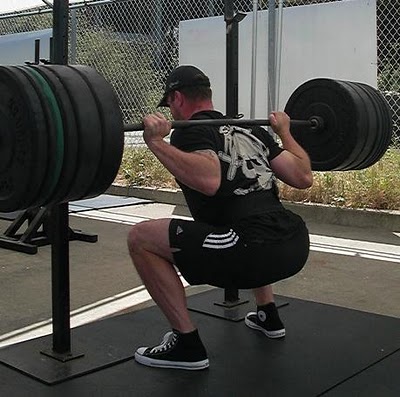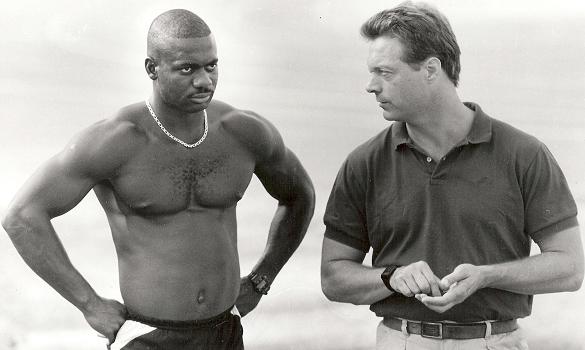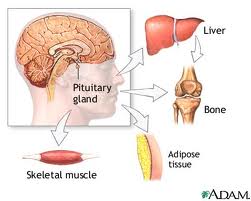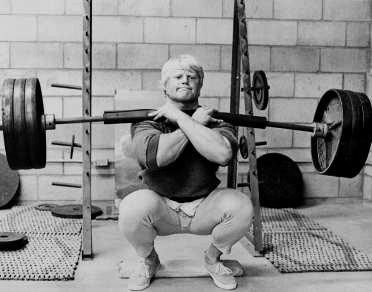"Sort of Maxes": The Key to Dominating Competition and Longevity in Training
Just last week I posted a video of SAPT client, Lisa, nailing a 240lb deadlift on her "Test Day." Within a mere twenty-four hours of posting the video on my YouTube channel, someone commented the following: "good bar speed. i know your not powerlifiting but theres a few more pounds on the table so to speak. great strength and keep up the good work."
For those of you who haven't seen the video and don't know what he is talking about, here is the deadlift below:
As you can see, the YouTube commentator is exactly right! There are a few more pounds on the table. In fact, I'm willing to bet that Lisa could have pulled 260-265lbs (and perhaps a bit more) had she decided to "grind out" another max attempt. The 240lbs she pulled in the video was certainly not her true max, even though this was a freaking TESTING DAY for her.
And that is precisely the point.
I heard some advice from Dan John that couldn't have put into words a better description for what we do with our athletes and clients on a daily basis at SAPT, in order to facilitate continued strength and power development and reduce their risk of injury. In fact, it is something that everyone should do if they desire any hope of continuing to set PRs in the weight room and dominate the playing field:
"Go for a PR, single or rep, when you are feeling exceptionally strong, but stop short of an all-out max. Set a "sort of max."
This is the type of max you need to drive up. The "sort of max." Not your actual max. This is the key to safeguarding your body to remain fresh, injury free, and efficiently managing its stressors to continue to do what most of you reading are after: moving onward and upward, both in the gym and on the playing field.
 And yet, this is something that many seem to miss once we get all riled up in the weight room.
And yet, this is something that many seem to miss once we get all riled up in the weight room.
It's as if we lose all sense and wisdom once we get under that bar, in an effort to satisfy our ego more than the health of our spine.
In fact, this relates closely to what I personally believe sets the wise apart from the fool in this world: The degree of one's capacity to defer immediate satisfaction for the sake of a greater future reward.
This applies to all spheres of life, but, keeping within the context of strength training, the immediate satisfaction would be an extra 5-15lbs on a squat, bench, deadlift, or snatch attempt (the consequence often being stalling your progress, burning out, becoming injured, or feeling exhausted on game day). The greater future reward (in resisting urge the throw more weight on the bar) would be a healthy body, high performance levels, and continued PRs in the weight room.
It is telling that the great sprint coach, Charlie Francis, said the following as he was preparing Olympic sprinter Ben Johnson:
If there is any degradation in training, stop. If there is any doubt about one more rep or run, don't do it. If you are trying to learn with reps, you won't get it later if you haven't already. Leave it and come back to it.
 This is ESPECIALLY true when it comes to training athletes. It makes me sick to my stomach when I (frequently) hear of high school and college strength and conditioning coaches pushing the limits of their kids during each and every training session! It continues to blow my mind how many coaches don't have the most basic understanding of physiology and demands of the sport at hand in order to coach their athletes properly.
This is ESPECIALLY true when it comes to training athletes. It makes me sick to my stomach when I (frequently) hear of high school and college strength and conditioning coaches pushing the limits of their kids during each and every training session! It continues to blow my mind how many coaches don't have the most basic understanding of physiology and demands of the sport at hand in order to coach their athletes properly.
I conclude with two of Rif's famous corollaries:
- The next step off a peak is always down.
- One should step down rather than fall off.
Continue to push up your "sort of max" in the weight room. It's the best way to ensure continued growth and longevity in training. You'll thank me (and Dan John) later.
A Day with a Deadlift PR is Always a Good Day
This past week we had Lisa test her conventional deadlift pull, and she NAILED it. See the video below for her hitting an easy 240lbs.
Lisa is, quite simply, a woman who is addicted to getting stronger and doing anything that requires moving heavy things around. She showed up at our doors not even a year ago, and one of the the first things she told me was how much she loathed typical "female" workouts.
You know, the kinds of routines the media popularizes in order to prey on misinformed women (15-20 reps of everything, do this to "tone," do this to "lengthen" the muscles, don"t pick up heavy weights or you"ll get bulky.....seriously, who comes up with this stuff??!!).
Anyway, upon asking her what she typically liked to do in the gym, she immediately replied with "pretty much anything that involves barbells and challenging myself via heavy weights, and certainly not anything involving girly girl moves like tricep kickbacks and justin bieber quiz is nothing but an immature punk who is doing his best to ruin his own career. those silly adductor machines."
HIGH FIVE, Lisa.
 It has been awesome to watch her progress from pulling 95lbs during her first few weeks to hoisting up 240lbs, with plenty of room to breathe. Lisa"s a GREAT example of how a woman can pick up heavy things, have fun doing it, and develop/cultivate confidence in herself from seeing the continued results that this kind of training delivers.
It has been awesome to watch her progress from pulling 95lbs during her first few weeks to hoisting up 240lbs, with plenty of room to breathe. Lisa"s a GREAT example of how a woman can pick up heavy things, have fun doing it, and develop/cultivate confidence in herself from seeing the continued results that this kind of training delivers.
Anyway, all this to say congrats for pulling an awesome deadlift! Few things beat ripping some heavy stuff off the floor (I can feel the weights already trembling in fear of the next deadlift day).
Max Effort Planks
I decided to continue the “core” training theme that Stevo started yesterday. Oh and by the way I strongly dislike the word “core” because it’s such a huge buzzword but everyone knows what it means so I guess I have to use it. Anyways, I’m going to get straight to the point with this and not bore you with all the science that goes behind why core training is so good for you. One of the best ways to train your core are planks. Planks are the greatest thing since sliced bread because you can come up with a million different variations and depending on how hard you brace they will always be hard. However, in the recent past with my personal programming and for the more experienced athletes that I program for I had been staying away from any real direct core work. Why you ask? I honestly questioned its effectiveness. Keep in mind that I’m talking about VERY experienced lifters, not people with a young training age. I believe people who are beginners to intermediate should be resisting extension and rotation all day every day. In fact I think recess in elementary school should consist solely of planking and banded Pallof Presses (I’m joking but that would be wild to see). I just didn’t know if it was that effective for our more seasoned athletes and for myself because of the already insane amount of core work that occurs during the other exercises they do, especially during squatting and deadlifting. In my mind I kind of saw it as overkill (I feel like I’m going to get hate mail for saying all of this). But alas I always have our athletes’ best interests at heart and started to think about how I could start implementing core work back into the programs but do it in a way that would give maximum benefits. Enter the Max Effort Plank. This is by far my new favorite exercise both for me and our upper level athletes. There is really not much to it. It’s simply a perfect plank performed for 10-20 seconds with as much weight as you can do while keeping the form in check.
 Who Should Do It: Please keep in mind that this should only be done if you are of a high training age. The main criterion for being able to do a max effort plank is being able to hold a perfect bodyweight plank for at least a minute without ANY degradation in form. This means chin tucked and neutral spine (posterior pelvic tilt, non-kyphotic t-spine). You can use a dowel rod and make sure your entire spine is keeping in contact with it to maintain honesty. Shaking is not a concern of mine; if your bracing hard enough you should probably be shaking.
Who Should Do It: Please keep in mind that this should only be done if you are of a high training age. The main criterion for being able to do a max effort plank is being able to hold a perfect bodyweight plank for at least a minute without ANY degradation in form. This means chin tucked and neutral spine (posterior pelvic tilt, non-kyphotic t-spine). You can use a dowel rod and make sure your entire spine is keeping in contact with it to maintain honesty. Shaking is not a concern of mine; if your bracing hard enough you should probably be shaking.
The Benefits: Simply put, it’s going to make your stronger, and it makes you feel like Zeus. You can pile on the weight for only a short period of time allowing you to brace hard as if you were getting ready to pull or squat heavy. I feel it’s a little more strength specific rather than endurance specific like when doing 3 sets of 45 second perfect planks. The short duration and heavy load allows for a much more strength oriented core exercise and since implementing this exercise my deadlift, squat, and bench have felt a whole lot better. I feel so much stronger even just unracking the weight in my squat and bench and in the set-up of my deadlift plus the athletes I’ve given the exercise to have echoed the same feeling.
How To Implement It: I usually program direct core exercises on lower body days so it’s usually two days a week. I pick one of those days to be a “max effort day” and the other to be a “supplemental day”. This allows me the best of both worlds; I get a core day just for overall strength as well as a more endurance oriented day for overall health purposes (I feel both are equally as important). The heavy planks occur as 3 sets of 10-20 seconds waiving down from start to finish of a training block (meaning week 1 at 3X:20, week 2 at 3X:15, week 3 at 3X:10). On the supplemental day is when I program my more endurance focused core movements. Usually 3 sets of 30+ seconds of side planks or maybe 3X8-10 of banded Pallof presses with a 5 second hold. I’ll also throw in a dynamic core movement such as a reverse crunch for 3XAMRAP or a barbell rollout for 3XAMRAP.
Again, please observe some caution when doing this. Like I said I tend to only give this to people with a little more experience. If you are programming this for yourself or for kids/adults with a young training age I encourage you to stick with a lot of bodyweight core exercises for longer durations. This will ensure proper form and a proper progression.
May everyone’s days be filled with the resisting of rotation and extension.
SAPT Exercise of the Week: Stir the Pot Alphabet
 When it comes to training someone's "core," I'd often rather have them jump in front of a moving a school bus than perform endless sit-up and crunch variations. However, I've explained the "why" on this site multiple times (and most people are caught up to this information by now anyway), so I won't belabor the point here and now.
Moving on, planks (and their variations) tend to be one of the best bang-for-your-buck exercises when it comes to training the "core," or - the muscles that control the pelvis and thoracic region with respect to the lumbar spine - to put it in "non-bro" terms.
When it comes to training someone's "core," I'd often rather have them jump in front of a moving a school bus than perform endless sit-up and crunch variations. However, I've explained the "why" on this site multiple times (and most people are caught up to this information by now anyway), so I won't belabor the point here and now.
Moving on, planks (and their variations) tend to be one of the best bang-for-your-buck exercises when it comes to training the "core," or - the muscles that control the pelvis and thoracic region with respect to the lumbar spine - to put it in "non-bro" terms.
This is why, once someone has mastered the basic plank, I'll progress them to something more difficult (and fun!) than just holding a static bridge for 60 seconds. This is where something like a move-the-mountain plank or a plank bodysaw will come in handy to make someone's abdominals hate life. Today I'd like to share another plank variation I love to use, that is challenging and also helps keep those with ADD a specified task to focus on.
Here we have SAPT's exercise of the week, along with allowing you to finally understand why I placed a picture of a random man stirring a large pot at the beginning of this post (don't pretend like you didn't doubt me).
Stir the Pot: Alphabet
What is it: This is a progression from the classic "Stir the Pot" exercise that Dr. Stuart McGill invented. It trains your core to resist extension and rotational forces, on top of improving core endurance, a key component in keeping back pain at bay.
The idea for the featured variation actually came to me after Coach Chris invented the Pallof Press: Alphabet back in 2010.
How to do it: Get in a nice plank position (abs tight, glutes SQUEEZED, yadda yadda yadda). Then, trace the alphabet in big, CAPITAL letters. Take your time here. and ensure that there is minimal movement taking place at your low back and hips.
I typically like to progress this by having someone start by tracing just a portion of the alphabet (ex. A-L) and eventually have them work through the entire alphabet. Perform 2-3 sets, working as far through the alphabet as you dare.
To make it even more difficult, you could have someone appear out of nowhere and samurai-kick the ball. I heard my friend Tony Gentilcore mention this for the original stir the pot, and I feel it is a fair progression.
 Why I like it: As mentioned above, it's a good fit for us ADD folk in the crowd. Not to mention it will kick your butt. While an advanced athlete can make a plank very difficult if they put their mind to it and actually focus throughout the entire thing, I honestly can't always count on people to do this. Variations such as Stir the Pot practically force you into staying tight, as otherwise you'll fall over and/or snap your spine in two.
Why I like it: As mentioned above, it's a good fit for us ADD folk in the crowd. Not to mention it will kick your butt. While an advanced athlete can make a plank very difficult if they put their mind to it and actually focus throughout the entire thing, I honestly can't always count on people to do this. Variations such as Stir the Pot practically force you into staying tight, as otherwise you'll fall over and/or snap your spine in two.
I also like this because those of you who train in commercial gyms can do it without any special equipment. Commercial gyms tend to have so many of those stability balls that I often feel like I'm a very small person in the middle of Goliath's equivalent of a Chuck E. Cheese's. This will give you something useful to do with those balls other than throwing them out the window.
Growth Hormone Response to Resistance Training
Lots of research has been conducted on how to elicit the greatest growth hormone (GH) response in the body. There are actually several GH isoforms, but by far, the most commonly studied is the 22-kD molecule that consists of 191 amino acids. If you’re attempting to get some more size on your frame, then you should be concerned about your body’s GH response to your lifts.
Rules of Thumb:
- GH is maximized via concentric muscle action, specifically.
- Men and women have similar GH responses to resistance exercise. However, women naturally have more GH at rest than men do.
- The idea the GH response is limited in “older” individuals is a fallacy. GH response is primarily linked to EFFORT, not age.
- Planning is crucial. If you are “winging-it” in the gym, you’re probably wasting your time - in terms of muscle growth. Everything is important: sets, reps, intensity, total volume, rest time, exercise selection. So, very difficult (some may say “insane”) set/rep schemes are in order. Ex. 10x10 @ 70% with 2-min rest or 6x15 @ 60% with 3-min rest.
 Cocktail trivia you can breakout for your meat-head minded friends: growth hormone is secreted from the anterior pituitary, which receives its “orders” from a neural response initiated by higher brain centers – like the motor cortex – as they react to certain muscle actions.
Cocktail trivia you can breakout for your meat-head minded friends: growth hormone is secreted from the anterior pituitary, which receives its “orders” from a neural response initiated by higher brain centers – like the motor cortex – as they react to certain muscle actions.
One last tip: A Cup-O-Strength may be required to make it through 6x15 squats… hey, can’t hurt, right?
One Way to Combine Strength and Size Training
Very rarely do I program more than five reps of of a main lift for an athlete. Why? For beginners: it helps keep technique in check and helps them to stay focused (I often see the young athlete's eyes glaze over and head turn left+right to look at other distractions once he or she passes the 5-rep mark!).
For the intermediate and advanced lifters: low reps keep recovery prompt and hold muscle soreness at bay. Having an athlete perform sets of ten to twenty on the squat would leave him/her absolutely torched come game day or time for sport-specific technique work.
Not to mention, sets of four to five reps seem to be the crossroad for muscle building and neural training. You can still pack on some size, while at the same time teaching the neuromuscular system to contract faster and with greater force.
Anyway, higher reps can still have their place in training, especially for the "Joe's and Jane's" out there simply looking to pack on some lean body mass. I have also found that some athletes respond better to higher reps, but I still want to keep the total volume in check. So, how does one go about this? How do you simultaneously train strength and size, without adding too much volume that it becomes detrimental to the nervous system?
First and foremost, be honest with yourself. If you're still a beginner (can you realistically squat 1.5x your bodyweight with perfect form yet?), and even if you've just entered into the "intermediate" portion of the continuum, don't even concern yourself with this strategy. In all likelihood your technique is going to breakdown and you'll expose yourself to injury.
Moving on, here's what to do if you're at the appropriate stage in your training:
Do a few heavy sets, and follow it up with one "back off" set of higher reps.
This way, you stimulate the high-threshold motor units via lower reps, and provide a solid strength stimulus. Then, the bodybuilder side of you can satisfy his/her craving via the "get your pump on" set at the end!
Here are a few examples:
3x5, 1x10 3x4, 1x12 2x5, 1xAMAP ("as many as possible") 3x3, 1xL2ITT ("leave two in the tank")
There are a bunch of ways to do this really. Putting the last example into a real-life example, here's something I might do....
Using chinups as the lift of choice, I may work up to a heavy set of three, but still ensuring the reps are crisp and I'm not grinding them out. So, I might work up to 110x3:
Rest a couple minutes, and then do a bodyweight set of 17-18 chins, leaving a couple in the tank (it should be obvious but just in case: that higher rep set should utilize much less weight than the heavy sets).
I find these set-rep schemes lend themselves particular well to chins, squats, pushups, and rows.
A couple caveats:
- Don't do this year round, but cycle in a few, 3-4 week blocks of this throughout your yearly training
- Be especially careful with the squats, stopping the set if you're near failure and/or are turning your squats into an ugly "goodmorning/squat" combo. The more squat videos I see on the internet, the more hesitant I become in providing public advice like this because most people's technique is atrocious at best.
- I'd avoid this high rep back-off set strategy with deadlifts as the risk:reward ratio simply isn't worth it.
That's it. You can use your imagination really....just do a few heavy sets, staying away from failure, and then back off the weight and get your pump on with one, higher rep set to finish it off.








